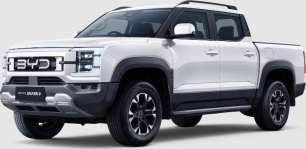Here’s where a vehicle like this stands or falls. Because if something like a Tourneo can’t cope with lots of people and their luggage in a single bound, then there’s really not much point to it, is there? I mean you’re not going to buy it for its sporty looks or supercar dynamics, so unless it works brilliantly as family transport, it’s kind of dead in the water. Fortunately Ford seems to have got it right. Mostly, anyway.
That starts up front where the two front seats feel like they’re metres apart. In reality, this huge gap forms a walk-through function for getting access to anything or anyone misbehaving in the second or third row of chairs. But you can’t help wondering what if… What if Ford had ditched the stubby centre console and added a third front-row seat? Wouldn’t a nine-seater be better than eight?
But the seats themselves are comfy and the high-and-mighty driving position gives plenty of vision in every direction. With one exception. And that is when you’re pulling out of a side street on to a main road and need to see what’s coming from the left. Depending on the angle you’re on, the fat frame of the pop-out side window (in the sliding door) becomes a blind spot, especially for taller drivers.
There’s nothing irretrievably wrong with the way the controls are laid out, but they will take some acclimatisation. That goes for the menu system on the touchscreen as well as the column-mounted shifter wand which is about the same size and shape (and in the same place) as a conventional indicator stalk. Tip the lever accidentally and you’ll wind up in neutral, wondering what just happened. The manual-shift mode is also fiddly to use and paddle sifters would be vastly better. Most won’t bother anyway.
The front cabin is home to a shallow lidded bin in the centre console, a deeper bin below that and a couple of charge points. There are also cup-holders in great spots up high in the corner of the dashboard, a shelf across the top of the dashboard and no less than two gloveboxes (the top one is pretty shallow) thanks to moving the passenger’s airbag into the roof lining. Both front doors also feature bins and storage nooks but there’s a fair bit of hard plastic on show, surely a legacy of the Tourneo’s parcel-van DNA.
The Tourneo’s party trick is the way both the second and third rows of seats can be slid to almost any point on a pair of tracks in the floor. The move is simply accomplished via a lever at the front or a rip-cord in the back of the seats, and all three centre-row seats can be moved individually (the third row is split 60:40). The upshot is that you can have all three rows bunched together for a large luggage space, or the rear row pushed right back to form a rear row with huge legroom. Don’t need all eight seats? How about a second row with the two outside chairs in place and the centre one folded forward to expose a work-surface with built-in cupholders.
But it gets even better, because individual seats can be removed to suit the weirdest of loads and the second-row seats even swivel 180-degrees to form a loungeroom on wheels. The kids will be begging you to take them for a drive in this thing.
The seats fold forward, but they don’t tumble. They don’t need to really, and they don’t fold into a bed either. But if you fancy camping in the Tourneo, you can remove both rows of rear seats for a huge flat floor.
The second row is home to storage bins in each sliding door (yes, a door on each side) a pop-put window that opens only about 40mm, temperature controls, air vents and reading lights. The third row, meantime, is not only easily accessed provided the second row isn’t slid all the way back (at which point you wouldn’t be using the third row anyway) but the good news is that the rearmost seat itself is basically three bucket seats with the same comfort levels (high) as the second row. There are also reading lights and a pair of phone pockets and cup-holders in the last row, too. Only the way the track system works and the shape of the seat base means that foot-room is limited to an extent.
With all three rows in place, but pushed as far forward as they can go, there’s a long load area of up to 725mm. But you can also push the second and third rows all the way back and have a cargo area 2622mm long behind the front seats. Maybe the van DNA is a good thing after all.
With all eight seats in place, there’s a minimum of 673 litres of luggage space which can be expanded all the way to a monster 4683 litres with the second and third rows removed.
There’s also a 12-volt power socket and a lighting system in the back, too, although while the side doors are automatic, the tailgate is manual. And you’ll need plenty of real estate to open it, too. Even tall folk will hit the button to open the tailgate, start the strut-assisted opening and then take a step or two back to allow the huge tailgate to rise without clobbering them. An automatic tailgate where you hit the button and run away to a safe distance would be much nicer.






